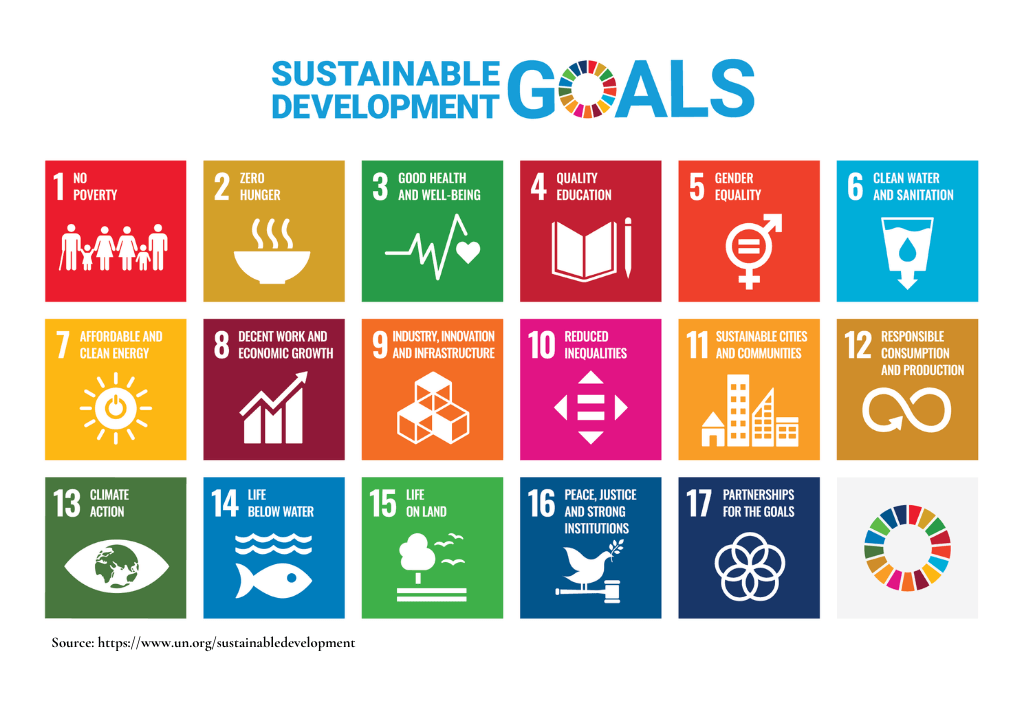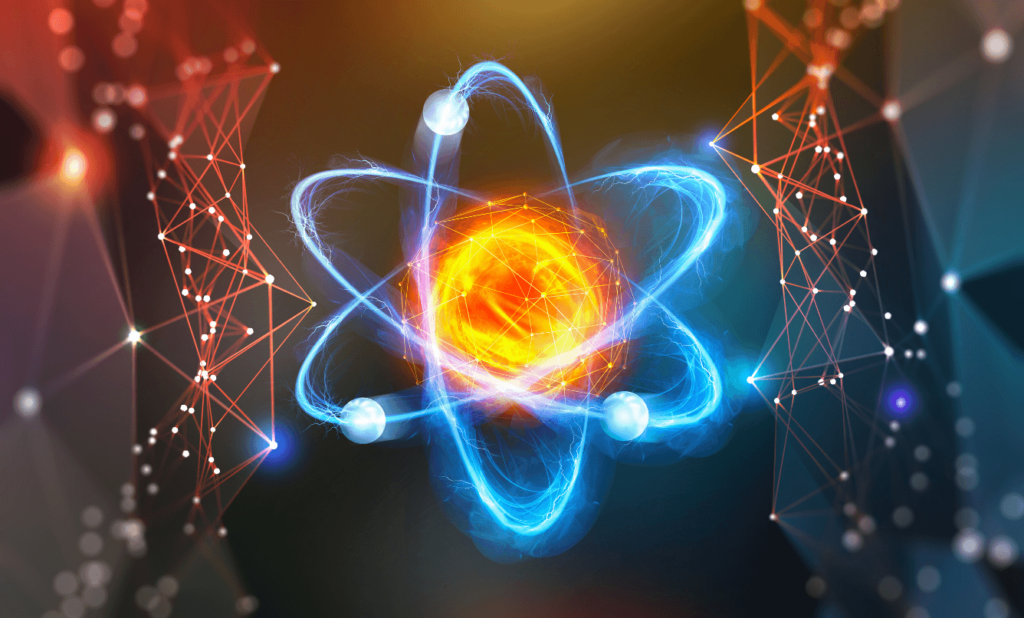Witold Kowalczyk, Global Channel Partnership Director for quantum computing firm Zapata Computing, has identified five SDGs that will be affected by the advent of quantum computing: [1]
- SDG 2: Zero hunger — More efficient nitrogen fixation to enhance food supplies
- SDG 3: Good health and well-being — Faster and cheaper drug development
- SDG 6: Clean water and sanitation — Enhanced water treatment capabilities
- SDG 7: Affordable, clean energy — Energy system optimization
- SDG 13: Climate action — Improved weather modeling and analysis
Other contributors to our report have cited the SDGs in the context of their sector-oriented discussions. As they highlight, both the private and public sectors are increasingly using the Goals as a reference point for their efforts. In this section, we look at the potential of QC from this “SDG perspective,” and where relevant, provide additional promising use cases.
SDG 2: Zero hunger — More efficient nitrogen fixation to enhance food supplies
Achieving food security is more complicated than “just” eradicating hunger. The 2019 UN World Population Forecast report stated that the world population is expected to increase by 2 billion in the next 30 years, to 10 billion in 2050. According to the UN Food and Agriculture Organization, we must produce 60% more food by 2050 to feed this projected population.[2]
Further, even as conflict continues to displace people, disrupt livelihoods, and undermine economies, the COVID-19 pandemic and related containment measures have exacerbated and exposed the vulnerabilities and inequalities that are pervasive throughout local and global food systems. Economically vulnerable families have been hit particularly hard. In 2020, more than one-third of the world’s population – around 2.4 billion people — was affected by moderate or severe food insecurity, an increase of nearly 14% from 2019. In the worst cases, people went without food for one or more days. Sub-Saharan Africa saw the highest incidence of food insecurity (56.8%), while Latin America and the Caribbean experienced the most rapid growth in food insecurity, with the percentage of the population at risk increasing from 25% in 2014 to 41% in 2020. The World Bank estimates that as the economic impact of COVID-19 worsens, the number of people suffering from severe hunger has increased. [3]
How can quantum computing help?
Traditional farming techniques may not be able to meet the growing demand for food, and the effort to do so will put excessive pressure on our natural resources. [4] This worrying situation requires that the food and agricultural sectors look for more effective and sustainable ways to meet these needs. Quantum computing may offer critical solutions. One specific example is achieving more efficient, less energy-intensive ways to produce fertilizer.
Currently, it takes one ton of fossil fuel to process nitrogen, a key soil nutrient, into enough nitrate for use in one ton of fertilizer. Although nitrogen, along with potassium and phosphorous, is essential to soil health, it can only be absorbed in the form of nitrate. This is currently achieved using an industrial technology called the HaberBosch process, which requires high heat and temperature to trigger the process of “fixing” nitrogen and accounts for 1-2.5% of global CO2 emissions annually.[5]
Quantum’s tremendous computing power may well open the door to a more effective method of fixing nitrogen for use in fertilizer, by enabling biochemical experts to better decipher how the various stages of ammonia production work at the molecular level. [6] Such a development could have far-reaching social consequences. Most importantly, the less energy-intensive process yields cheaper compost, thereby reducing the cost of providing food. This is an important step in solving the global hunger problem in accordance with the UN’s zero hunger goal.
SDG 3: Good health and well-being: Faster and cheaper drug development
The COVID-19 pandemic revealed deeply ingrained weaknesses in healthcare systems around the world. Lack of funding as well as insufficient drugs and equipment all left hospitals ill prepared for the outbreak. The pandemic also highlighted the critical connections between SDG 3 and other global goals such as SDG 8 (Decent Work & Economic Growth) and SDG 4 (Education). Further, the pandemic made painfully obvious the economic disparities across nations and communities; lack of access to quality care, medicines and medical supplies, and more recently to vaccines, in economically disadvantaged areas has led to greater mortality. [7] [8]
A 2017 Report of the World Health Organization states that “1 out of 10 circulating medical products in the lower and medium income countries is already lacking or counterfeit.”[9] Substandard drugs “do nothing but prolong sickness, waste money and erode hope. At worst, they kill, cause serious harm, and fan the flames of drug resistance.”
More recently, a report by the United Nations Office on Drugs and Crime notes that in March 2020, Interpol reported global seizures of counterfeit medical products related to COVID-19, including $14 million in counterfeit and substandard face masks. The report states, “Compared to an earlier operation in 2018, Interpol reported an increase of about 18% in seizures of unauthorized antiviral medication and a more than 100% increase in seizures of unauthorized chloroquine (an antimalarial), indicating a surge in substandard and falsified medical products and unauthorized medication circulating in the market that likely to be connected to the COVID-19 pandemic.” [10]
How can quantum computing help?
As noted by contributor Carly Anderson, traditional drug discovery and development processes are complex and lengthy, with trial and error an accepted cost. Quantum computing allows for more in-depth research on complex, multifactorial diseases that require adjustment of many targets. It should minimize the need for expensive and time-consuming in vitro testing. In the future, quantum computing may even enable end-to-end drug development within a chip. [11]
Quantum computers may not only help the world solve complex health problems, but also enable progress toward the aspect of SDG 3 that pertains to targeting drug research and development efforts toward “diseases that primarily affect developing countries,” providing access to medicines for all.”
As more effective drugs are more produced more efficiently, it becomes more profitable to distribute them widely, and to make them available within lower income communities across the globe. As this happens, the quality drug solutions should crowd out the ineffective and harmful imposters that are touted as medical solutions.
SDG 6: Clean water and sanitation — Enhanced water treatment capabilities
Sustainable Development Goal 6, “Ensure access to water and sanitation facilities for all,” is important for long-term economic development. Clean water and sanitation are essential for improving diet, preventing disease, and promoting health care, as well as the normal operation of schools, workplaces, and political institutions, and the full integration of women, girls and vulnerable groups into society. [12]
Global water and sanitation problems affect hundreds of millions of people every day. Unsafe water and lack of access to basic sanitation facilities combine to cause extreme poverty.[13] As noted by the International Finance Corp in a 2020 report, cites alarming risks, including “(a) global warming, which has led to an increase in extreme floods and droughts, challenging the resilience of water and sanitation systems, (b) increasing number of people living in areas facing water stress (currently 2 billion), which increases supply vulnerabilities, (c) rapid urbanization, which strains existing water resources and ecosystems, (d) the emergence of megacities, which adds the challenge of extending water and sanitation services to about 1 billion people living in informal settlements not served by water grids, (e) aging infrastructure, which has increased pressure to accelerate investments in more advanced markets, following decades of underinvestment.” Climate change continues to threaten the progress made in reducing the severity of the global water and sanitation crisis. [14]
How can quantum computing help?
Report contributor Matthew Sheldon offers potential applications for quantum computing in the water utilities space. In addition to the use cases he cites, advances in quantum computing and molecular simulations may increase global efforts and capabilities for effective water treatment. In terms of reverse osmosis water purification, quantum computers can promote the progress of membrane technology through quantum simulation. In addition, quantum computers could also accelerate the use of heterogeneous catalysts, which could directly convert toxic molecules within the water into nontoxic products, similar to how catalytic converters in cars transform pollutants from fuel combustion.[15]
SDG 7: Affordable and clean energy — Energy system optimization
“Energy poverty” affects both developing and industrialized countries. According to the G20’s Energy Transition Working Group and Climate Sustainability Working Group,[16] energy poverty “occurs when households or territorial units cannot fulfill all of their domestic energy needs (lighting, cooking, heating, cooling, information-communication) as a result of lack of access to energy services, an inability to afford them, or their poor quality or unreliability …” Currently, millions of people endure extreme energy shortages, and suitable, cheap electricity is not available on an equitable basis. [17] In addition, global energy demand and consumption are expected to increase, especially in countries with higher economic growth, such as India and China. [18]
SDG 7 aims to “universalize cheap, reliable and modern energy services” by 2030 along with improving the efficiency and technology of energy services. Achievement of SDG 7 would generate many health, economic, and climate benefits, improving the resilience of communities and economies in the face of health or climate disasters. Further, access to reliable and sustainable energy can improve irrigation, increase agricultural production and increase the productivity of local agriculture. [19] Farmers can ensure harvest value through refrigeration or increase profits through further processing,[20] and small businesses can enter new markets. [21] Ending global poverty begins with the elimination or resolution of energy poverty by investing in effective, efficient, and reliable renewable energy. [22]
How can quantum computing help?
The growing demand for energy has prompted business leaders and policymakers to rethink the complexity of the global energy system, which increases with its expansion.[23] For instance, the growth of distributed energy and the emergence of new load categories such as electric vehicles have exponentially increased the amount of data required for network maintenance, analysis, and optimization. This expansion also places additional requirements on the existing security and communications infrastructure.[24] The manufacture of efficient and reliable batteries for solar panels, which is essential for renewable energy sources such as solar energy, is another complex challenge that must be solved in order to end global energy poverty.
Quantum computers can help address these issues through the development of decentralized energy systems that are not too complex and are optimized to meet ever-increasing energy demand. Quantum computing is expected to be able to solve the complex challenges of optimizing power plants, large wind turbines, and dynamic heating, which require more robust solutions than those provided by today’s analytical approaches. Similarly, quantum computers can help optimize energy networks that are comprised of thousands of distributed energy (“DER”) systems, thereby increasing the vitality of energy systems. [25]
Energy security is another challenge that quantum computers can help solve. Quantum computers can be used to protect critical energy infrastructure from cyber threats. [26] Furthermore, quantum computation techniques could help develop new materials for better batteries, more efficient solar cells, and lighter and more efficient wind turbine blades, all of which will scale up the renewable energy production that is essential to closing global energy poverty gaps and achieving SDG 7, thereby “ensuring access to affordable, reliable, sustainable, and modern energy for all.”[27]
SDG 13: Climate action — Improve weather modeling and analysis
Sustainable Development Goal 13 remains one of the most important SDGs because it calls for urgent global action to address the existential threats posed by climate change. [28] Climate change affects all aspects of human life, from agricultural production to health and safety. In fact, the U.S. government’s March 2021 Interim Strategic National Security Guidelines identified climate change as a national security issue that will affect health, the economy, security, and the planet.[29]
According to the IPCC 2021 climate change report, “recent changes in the climate are widespread, rapid, and intensifying, and impacts are affecting every region on Earth, including the oceans. Many weather and climate extremes such as heatwaves, heavy rainfall, droughts, and tropical cyclones have become more frequent and severe.” [30]
Global drought. Drought is expected to worsen in the next few decades, causing famine and hindering efforts to achieve SDG 2: “end global hunger by 2030”.[31] It is becoming more common in vast sections of Africa, the Mediterranean region, portions of North and South America, and Southeast Asia.[32] Madagascar, for example, is on the edge of famine as a result of climate change, with the worst drought in decades threatening half a million children under the age of five. Countries that are susceptible to drought are less likely to meet their SDG targets by 2030 because drought will compound the severe hardships they already face. Their already struggling agrarian economies will remain weak without investments that introduce stability and decrease fragility.[33]
Heavy rain. Changes in climate can influence precipitation intensity and frequency. While some regions will suffer more drought, other regions will be impacted by higher rainfall. The warmer waters add moisture to the atmosphere, increasing the incidence of heavy rain and storms. In 2021 alone, heavy and frequent rainfall and hurricanes have flooded countries in Western Europe and the United States, wiping away livelihoods, causing death and creating billions of dollars in property damage. A combined study by the U.K. Meteorological Office and the Institute of Atmospheric Physics of the Chinese Academy of Sciences concluded that communities around the world could experience extreme precipitation as global temperature rises. Extreme precipitation would lead to flood risk, severely impact drinking water, sanitation systems, agriculture activities, and the hydroelectric power supply.
Heatwaves. Heatwaves are increasing in frequency and intensity, adversely impacting health by worsening droughts, and fueling forest fires worldwide.[34] The European Space Agency cites that “fire affects an estimated four million square kilometers of Earth’s land each year and is responsible for releasing aerosols and greenhouse gases to the atmosphere.” [35]
How can quantum computers help deal with the existential threats posed by climate change?
Hurricanes, heatwaves, and other extreme weather events sometimes miss the radar of metrologists. In order for metrologists to predict extreme weather events, a large amount of data needs to be analyzed, including variables such as temperature, density, and pressure. Today’s classic computers are limited by their design and are prone to errors at moderate speeds.[36] Even traditional mainframe supercomputers are not fast enough to calculate the complex data used for weather modeling. [37]
Quantum computers will help meteorologists understand various weather patterns. After quantum computers are fully developed and deployed, traditional numerical techniques may be improved. [38] This can improve the tracking and prediction of weather conditions by effectively and quickly using the computing power of qubits and quantum-inspired optimization algorithms using a large amount of data with many variables. [39] Quantum machine learning can also be used to improve pattern recognition, which is important for understanding meteorological events.[40]Top of Form
The ability to accurately predict various extreme weather events will help communities and governments proactively prepare to avoid loss of life and property related to weather events such as flooding, droughts, hurricanes, heat waves, forest fires, etc.
Conclusion
The global community is on the verge of a technological revolution that will fundamentally change the way humans work, live, and communicate. The scope and complexity of this transformation will be different from anything humans have experienced in the past. As the world move more closer to the realization of the coming changes driven by advanced technologies, it is important to pay close attention to the revolutionary computing power that a quantum computer may soon deliver, and how this can help attain the 17 Sustainable Development Goals.
This article is one section of the report, “Quantum Impact — The Potential for Quantum Computing to Transform Everything.” Click here to learn more and access the full report.
Please see the PDF version of the full report for important disclosures.
[1] https://www.zapatacomputing.com/lets-make-quantum-computing-about-sustainability/
[2] https://www.un.org/en/chronicle/article/feeding-world-sustainably
[3] https://www.wfp.org/news/covid-19-will-double-number-people-facing-food-crises-unless-swift-action-taken
[4] https://www.pnas.org/content/104/33/13268
[5] https://www.bloombergquint.com/onweb/synthetic-fertilizer-ammonium-nitrate-makes-climate-change-worse
[6] https://sustainability.colostate.edu/humannature/cassidy-jackson/
[7] https://www.who.int/news/item/13-05-2020-people-living-longer-and-healthier-lives-but-covid-19-threatens-to-throw-progress-off-track
[8] https://doi.org/10.4269/ajtmh.20-0903
[9] https://www.who.int/news/item/28-11-2017-1-in-10-medical-products-in-developing-countries-is-substandard-or-falsified
[10] https://www.ctvnews.ca/health/coronavirus/interpol-121-arrests-made-over-counterfeit-covid-19-supplies-medications-1.4861432
[11] https://www.ncbi.nlm.nih.gov/pmc/articles/PMC6205278/
[12] https://www.who.int/life-course/partners/global-strategy/globalstrategyreport2016-2030-lowres.pdf
[13] http://www.fao.org/3/i7754e/i7754e.pdf
[14] https://www.ifc.org/wps/wcm/connect/126b1a18-23d9-46f3-beb7-047c20885bf6/The+Impact+of+COVID_Water&Sanitation_final_web.pdf?MOD=AJPERES&CVID=ncaG-hA
[15] https://doi.org/10.1021/acs.accounts.8b00642
[16] Executive Note for the G20 Energy Transition Working Group and the G20 Climate Sustainability Working Group Energy Poverty: addressing the intersection of Sustainable Development Goal 7 (SDG7), development and resilience,
[17] https://doi.org/10.1007/978-1-4615-5997-9_1
[18]. https://www.eia.gov/todayinenergy/detail.php?id=32912
[19] Ugo Bardi, Toufic El Asmar, and Alessandro Lavacchi. “Turning electricity into food: the role of renewable energy in the future of agriculture.” Journal of Cleaner Production Volume 53, 15 August 2013, Pages 224-231. Accessed September 13, 2021. https://www.sciencedirect.com/science/article/abs/pii/S0959652613002291
[20] Duc Anh Dang and Hai Anh La. “Does electricity reliability matter? Evidence from rural Viet Nam.” Energy Policy Volume 131, August 2019, Pages 399-409. Accessed September 13, 2021. https://www.sciencedirect.com/science/article/abs/pii/S030142151930285X
[21] Hemen Mark Butu, Benyoh Emmanuel Kigha Nsafon, Sang Wook Park, Jeung Soo Huh. “Leveraging community-based organizations and fintech to improve small-scale renewable energy financing in sub-Saharan Africa.” Energy Research & Social Science Volume 73, March 2021, 101949. Accessed September 13, 2021. https://www.sciencedirect.com/science/article/pii/S2214629621000426
[22] Pye Steve, Dobbins Audrey, Baffert Claire, Brajkovic Jurica, Miglio Rocco, and Deane Paul. “Energy poverty and vulnerable consumers in the energy sector across the EU: analysis of policies and measures.” Insight Observatory: Policy Report. May 2015. Accessed September 13, 2021. http://knjiznica.sabor.hr/pdf/E_publikacije/Energy_poverty_and_vulnerable_consumers_in_the_energy_sector_across_the_EU.pdf
[23] Aleh Cherp, Jessica Jewell, and Andreas Goldthau. “Governing Global Energy: Systems, Transitions, Complexity.” Global Policy. January 5, 2011. Accessed September 14, 2021. https://onlinelibrary.wiley.com/doi/abs/10.1111/j.1758-5899.2010.00059.x
[24] B. Gillessen, H. Heinrichs, J.-F. Hake, and H.-J. Allelein. “Natural gas as a bridge to sustainability: Infrastructure expansion regarding energy security and system transition.” Applied Energy Volume 251, 1 October 2019, 113377. Accessed September 14, 2021. https://www.sciencedirect.com/science/article/abs/pii/S0306261919310517
[25]https://ieeexplore.ieee.org/abstract/document/9494203
[26] https://ieeexplore.ieee.org/abstract/document/6997535
[27] http://pure.iiasa.ac.at/id/eprint/14621/1/SDGs-interactions-7-clean-energy.pdf
[28] Myers, T. C. (2014) “Understanding Climate Change as an Existential Threat: Confronting Climate Denial as a Challenge to Climate Ethics”, De Ethica, 1(1), pp. 53–70. Accessed September 13, 2021. https://de-ethica.com/article/view/1728
[29] https://www.whitehouse.gov/wp-content/uploads/2021/03/NSC-1v2.pdf
[30] https://unfccc.int/news/un-climate-change-welcomes-ipcc-s-summary-for-policy-makers-on-the-physical-science-basis-of-climate
[31] https://doi.org/10.3390/su10030622
[32] https://www.ipcc.ch/sr15/chapter/chapter-3/
[33] https://doi.org/10.1007/978-981-16-0902-2_6
[34] https://www.nationalacademies.org/based-on-science/global-warming-makes-heat-waves-hotter-longer-and-more-common
[35] https://climate.esa.int/de/news-events/multi-decade-global-fire-dataset-set-support-trend-analysis/
[36] https://ai4esp.org/files/AI4ESP1067_Kim_Grace2.pdf
[37] https://royalsocietypublishing.org/doi/10.1098/rsta.2020.0097
[38] Andreas Trabesinger. “Quantum leaps, bit by bit.” Nature volume 543, pagesS2–S3. March 23, 2017. Accessed September 16, 2021. https://www.nature.com/articles/543S2a
[39] Marcelo C. Cardoso, Marco Silva, Marley M.B.R. Vellasco, and Edson Cataldo. “Quantum-Inspired Features and Parameter Optimization of Spiking Neural Networks for a Case Study from Atmospheric.” Procedia Computer Science Volume 53, 2015, Pages 74-81. August 10, 2015. Accessed September 16, 2021. https://www.sciencedirect.com/science/article/pii/S1877050915017846
[40] https://www.energy.gov/sites/prod/files/2020/08/f77/OTT-Spotlight-Quantum-Information-Science-and-Technology.pdf




















